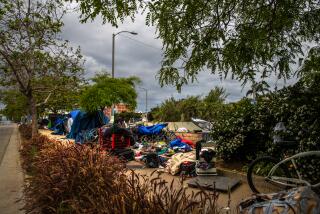Apartment Plans Divide City, School Officials
- Share via
Battle lines are being drawn between the Torrance Unified School District and the City Council over a district plan to build up to 120 apartments on the site of the former Columbia School.
The district’s interest in developing the 5-acre, triangular lot on 186th Street has raised harsh criticism from council members, who question the density of the project and fear it could include subsidized housing--a politically hot issue in Torrance.
“I don’t know where they’re headed, but I see potential problems,” said Councilman Bill Applegate, who last week asked city staff to investigate the district’s intentions.
The council’s criticism comes despite assurances by district officials that they do not intend to provide subsidized housing.
‘Never’ Part of the Plan
“Subsidized or low-income housing has never been a part of our plan,” said Paul Mackey, assistant superintendent for special projects. “I don’t know why they are worried.”
Columbia School, which once provided classes for mentally and physically handicapped children, has been vacant since 1987, when the program was relocated to Torrance High School. Columbia is one of several schools that were closed as enrollment declined. Some of the unneeded schools were sold or converted to other district uses.
Harvey Oelkers, the district’s assistant superintendent for business services, said criticism of the project is premature because the specifics of the project have not been determined. The council would have to approve a change of zoning for the project as well as the actual development.
“We are not sneaking off in the middle of the night and building something without anyone knowing,” Oelkers said.
The plan to develop the land would be a joint venture between the district and the Los Angeles County Community Development Commission, Oelkers said. The agency develops public-owned land and provides real estate advice to other public agencies at a nominal fee, said Judith Kendall, the commission’s director of community development and planning.
In July, school officials asked the commission to evaluate the vacant property and recommend how to get the highest financial return. The commission said the most profitable use would be a high-density apartment project, according to a report by Oelkers to the school board. The district is considering building about 120 two- and three-bedroom apartments on the site, Oelkers said, which would require a high-density zoning.
“The case can be made that R-3 zoning (high-density housing) is compatible with both the adjacent commercial zoning and the R-2 (medium-density housing), and addresses a shortage of multifamily housing within the city,” Oelkers said.
It has not been estimated how much the development may cost, but Oelkers said the district plans to borrow all of the money needed. He estimated that the profits to the district over a 10-year period could be as high as $13.5 million. The land alone is worth about $4.5 million, he said.
Once the project is completed, a private agency would be hired to manage the property, Oelkers said.
State law, however, requires that any profits from the sale of school lands go toward building improvements or purchase of other property, Oelkers said. By developing the Columbia site instead of selling it, the district can use the profits for operating expenses or any way it wants, he said.
‘Get the Most Out of the Property’
“The idea is to get the most out of the property that you can,” Mackey said.
Most council members said they sympathize with the district’s attempt to raise money, but several--including Applegate, Dan Walker and Tim Mock--said they fear that if the school board uses federal or county grants to pay for the project, it may be required to provide low-income housing.
Applegate said subsidized housing could bring down property values in the neighborhood. The area north of the site has medium-density, single-family and two-family homes. The area to the south and east is commercial. To the west are railroad tracks. Applegate said his opposition to subsidized housing, which has often served minorities, is not racially motivated. “It has nothing to do with race or anything else,” he said. “It has to do with the value of property.”
Walker shared Applegate’s concern. Even though district officials have said they do not intend to provide subsidized housing, he said, “that doesn’t give anyone any assurances that they won’t build it anyway.”
Subsidized housing is a sensitive issue with the City Council. In 1980, four council members faced recall petitions because they voted for a federal Housing and Urban Development subsidized housing project in order to continue receiving federal grants.
Faced with overwhelming opposition from residents, the council ultimately dropped out of the federal housing program. The recall effort was ultimately abandoned.
“It caused quite a fury,” said Mayor Katy Geissert, who was one of the council members who faced a recall drive.
Other council members said they opposed the project because they say it would be too dense for that neighborhood. “I don’t think that is the best use of the land,” said Councilman Mark Wirth.
Last month, the council asked city planners to recommend a new zoning for the site, which is now zoned for public use. Their recommendation is expected in several weeks. Wirth said he would prefer to rezone the land for medium density and have moderately priced, owner-occupied townhouses built.
The district’s interest in developing housing is shared in Redondo Beach, where the elementary school district is working with developers to build two senior citizen homes, one at the old McCandless Elementary School site and the other on the site of the former Andrews Elementary School.
Torrance District officials said a similar project is under way in Huntington Beach.
More to Read
Sign up for Essential California
The most important California stories and recommendations in your inbox every morning.
You may occasionally receive promotional content from the Los Angeles Times.














